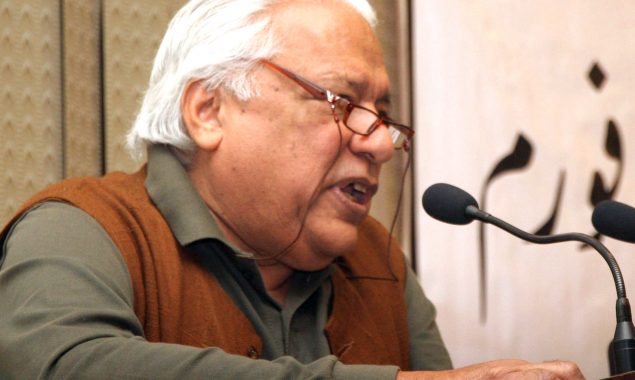
Veteran architect Arif Hasan. Photo: Athar Khan/Bol News
KARACHI: Karachi, one of the largest cities in the world popularly known as the ‘City of Lights’, now suffers from looming urban crises.
The metropolis does not have a mass transit system and universal access to potable water is a distant dream. Sanitation and drainage issues are persistent while power outages in commercial and residential areas are also common.
Above all these problems, the city is allegedly run by mafias, ranging from hydrants to transportation.
Veteran architect Arif Hasan has discussed nearly all of these issues in considerable detail. Talking to Bol News, he said that the provincial capital would not have so many issues if it were a poor city. “As Karachi generates the most wealth, people of different ethnic backgrounds find it easy to settle here.”
The land grabbers took full advantage of the mass migration to Karachi, he added. “In fact, mafias sprang up to exploit this situation. They started fulfilling their requirements, specially related to transport, water, land and housing through an unreliable informal sector. Since land use was controlled by a powerful developers’ lobby through bribes and coercion, they devastated the city.”
Moreover, the construction of high-rise buildings and massive registration of new vehicles on daily basis had made the city more chaotic as no serious traffic management and engineering plans were in place to accommodate the increasing numbers, he stated.
‘Ecological disasters’
“On the other hand, builders have constructed and are constructing high-rise buildings in the port city keeping in view the recently announced construction relief package by the PTI-led government. As such, in Karachi, many of these settlements are high rise with densities of over 1,000 persons per acre. Meanwhile gated colonies are being constructed for the elite on the city fringe with densities as low as 50 persons per acre.”
These colonies were ecological disasters as they were eating up orchards, forests, natural drainage systems, geological formations and historic sites, he further said.
Citing the example of Turkey, the architect suggested that the high-rise residential complexes should be restricted to ‘one-plus-four.’
There is a growing trend in Asian cities to demolish low-income informal settlements and relocate their residents in low-rise apartment blocks, he highlighted. “There is sufficient evidence to suggest that low-income groups are unhappy with the high-rise solutions for sociological reasons. Those living in the top floors suffer from the feeling of isolation and hopelessness.”
Hasan elaborated that posh neighbourhoods such as Defence Housing Authority had no signs of habitation for they lack the prerequisite of housing schemes. “For instance, one has to take a car to buy groceries or for that matter any edible items. You need a car to drop your children to schools. In short you just cannot afford to live without a car. A good housing scheme must have all these facilities available at a distance which can be covered just by walking.”
Moreover, the architect ruled out the idea that residential settlements being developed outside the Karachi limits like Bahria Town and DHA City were “smart, elegant and fashionable” localities.
According to Hasan, localities such Lalukhet, now Liaquatabad, as well as Federal B Area and Nazimabad could safely be termed as properly organised settlements. “Pedestrians live happily and comfortably in these localities. You can safely walk down to shopping areas without any hassle. Lalukhet has a rich post-independence history. It was named after the first prime minister of the country Nawabzada Liaquat Ali Khan.”
Vibrant culture
Federal B Area boasts of a vibrant culture, he asserted. “There are venues such as Saadaat-i-Amroha that have hosted many a memorable mushaira and sessions with literary giants. Some of the classic mushairas in Pakistan have taken place at Saadaat-i-Amroha, especially in the 1990s, in which poets such as Fahmida Riaz, Ahmed Faraz, Jaun Elia from Pakistan and Bashir Badr and Nawaz Deobandi from India took part.”
One of the most candid chitchats with Jaun Elia, too, was witnessed at this venue, he revealed.
Proper urban planning has never been the problem of Karachi, he claimed. It is in fact, purely political. It is a conflict between the federal government and the provincial government, the city administration and the provincial government. Unless these unending political differences are resolved, the problems of this megacity can never be solved. Although to live without hope is to cease to live, however, unfortunately there is no hope in sight, he observed.
The architect explained that the expansion of informal settlements, known as katchi abadis in Karachi, were a direct consequence of the policies of urban developers. “The government is unwilling to make land available for low-income workers in Karachi near their places of work although such land exists. Rather land is hoarded for speculation or for middle and high-income commercial development. Meanwhile, on the fringes of the city, tens of thousands of acres of land are being developed as gated housing societies with densities as low as 100 persons per hectare.”
These are evicted villages as well as destroyed historic archaeological sites and culture of the communities that once live here, Hasan claimed.
“As a result, it has become cheaper and socially beneficial to rent or purchase an apartment in an old katchi abadi near the city than live on the fringe.”
Catch all the Pakistan News, Breaking News Event and Latest News Updates on The BOL News
Download The BOL News App to get the Daily News Update & Follow us on Google News.




